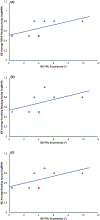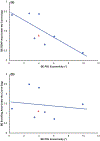Exploration of dynamic text presentations in bilateral central vision loss
- PMID: 34519359
- PMCID: PMC8808432
- DOI: 10.1111/opo.12881
Exploration of dynamic text presentations in bilateral central vision loss
Abstract
Purpose: Dynamic text presentation methods may improve reading ability in patients with central vision loss (CVL) by eliminating the need for accurate eye movements. We compared rapid serial visual presentation (RSVP) and horizontal scrolling text presentation (scrolling) on reading rate and reading acuity in CVL observers and normally-sighted controls with simulated CVL (simCVL).
Methods: CVL observers' (n = 11) central scotomas and preferred retinal loci (PRL) for each eye were determined with MAIA microperimetry and fixation analysis. SimCVL controls (n = 16) used 4° inferior eccentric viewing, enforced with an Eyelink eye-tracker. Observers read aloud 4-word phrases randomly drawn from the MNREAD sentences. Six font sizes (0.50-1.30 logMAR) were tested with the better near acuity eye and both eyes of CVL observers. Three font sizes (0.50-1.00 logMAR) were tested binocularly in simCVL controls. Text presentation duration of each word for RSVP or drift speed for scrolling was varied to determine reading rate, defined as 50% of words read correctly. In a subset of CVL observers (n = 7), relationships between PRL eccentricity, reading threshold and rate were explored.
Results: SimCVL controls demonstrated significantly faster reading rates for RSVP than scrolling text (p < 0.0001), and there was a significant main effect of font size (p < 0.0001). CVL patients demonstrated no significant differences in binocular reading rate between font sizes (p = 0.12) and text presentation (p = 0.25). Similar results were seen under monocular conditions. Reading acuity for RSVP and scrolling worsened with increasing PRL eccentricity (μ = 4.5°, p = 0.07). RSVP reading rate decreased significantly with increasing eccentricity (p = 0.02).
Conclusions: Consistent with previous work, reading acuity worsened with increasing PRL eccentricity. RSVP and scrolling text presentations significantly affected reading rate in simCVL, but not in CVL observers, suggesting that simCVL results may not generalise to pathological CVL.
Keywords: central scotoma; gaze contingent scotoma; low vision; macular degeneration; reading; simulated scotoma.
© 2021 The Authors Ophthalmic and Physiological Optics © 2021 The College of Optometrists.
Conflict of interest statement
CONFLICT OF INTEREST
The authors report no conflicts of interest and have no proprietary interest in any of the materials mentioned in this article.
Figures












References
-
- Friedman DS, O’Colmain BJ, Munoz B, et al. Prevalence of age-related macular degeneration in the United States. Arch Ophthalmol 2004;122:564–572. - PubMed
-
- Fletcher DC, Schuchard RA. Preferred retinal loci relationship to macular scotomas in a low-vision population. Ophthalmology 1997;104:632–638. - PubMed
-
- Shima N, Markowitz SN, Reyes SV. Concept of a functional retinal locus in age-related macular degeneration. Can J Ophthalmol 2010;45:62–66. - PubMed
-
- Lei H, Schuchard RA. Using two preferred retinal loci for different lighting conditions in observers with central scotomas. Invest Ophthalmol Vis Sci 1997;38:1812–1818. - PubMed
Publication types
MeSH terms
Grants and funding
LinkOut - more resources
Full Text Sources
Research Materials

